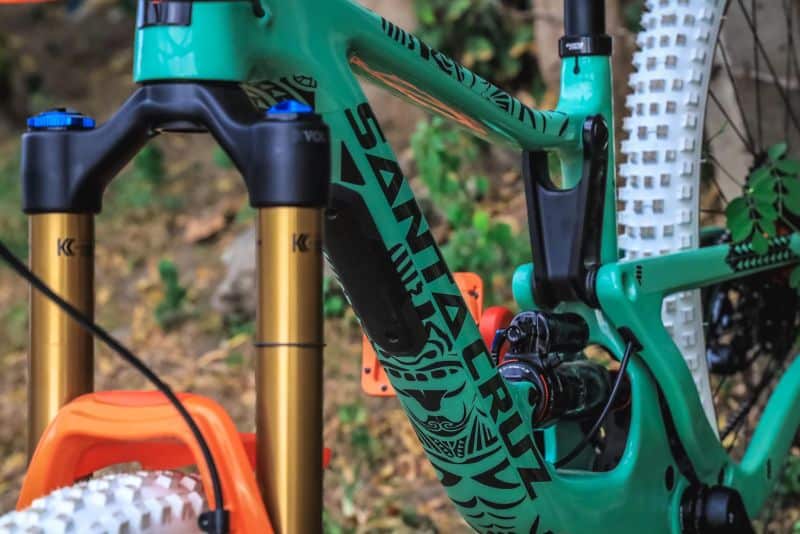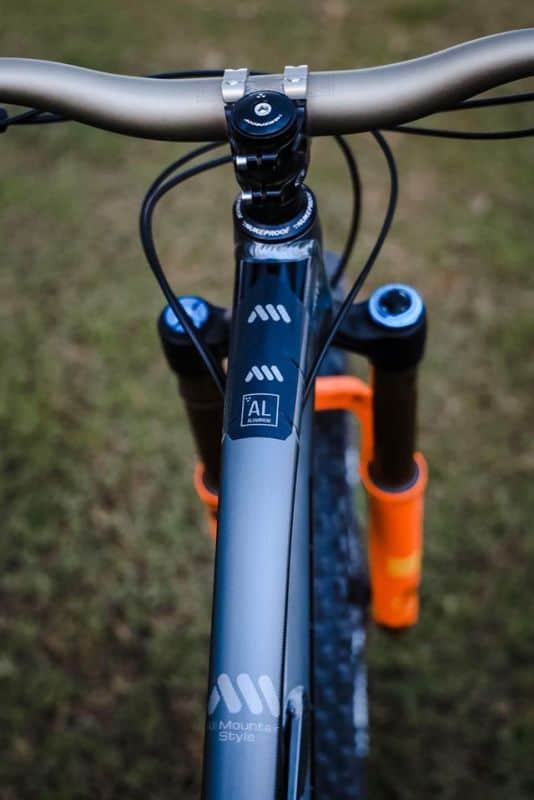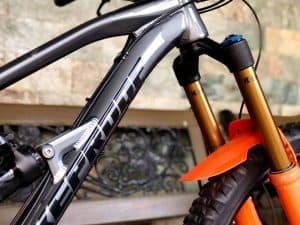Last Updated on March 10, 2022
Getting a new and more expensive bike can give you a surprise because it features new technology. This means that almost every part of your bike has more dials, switches, and buttons placed on it. One of the parts of your bike filled with multiple knobs and dials is the fork.
This part of your bike absorbs the impacts you will give your bike every time you ride the trails. Mountain bike forks contain a lot of knobs and switch to make your ride safer and more comfortable. These let you adjust the way it responds to specific scenarios on the trail.
One switch you’re usually going to see in a more expensive mountain bike fork is the lockout. Riders use this to climb steep uphills and go through flat sections without consuming too much energy.
This article will help you know more about the purpose of this part of your fork and how you can use it to your full advantage.
So, what is lockout on mountain bike forks?
Suspension Adjustments of a Mountain Bike Fork
Preload
The preload is on mountain bike forks that have coil-sprung suspension. They set the sag of your bike, which corresponds to your average weight during your ride. All you need to do to set this up is to twist the preload on the spring.
This then adds or removes more tension to achieve the exact amount of sag you want. But you won’t usually find this setting on your fork if you’re using the current high-end ones.
Most brands are using forks that rely on air canisters because they’re lighter and you can easily adjust them.
Meanwhile, most brands have already phased out coil forks. You can even just find them in low-end or budget forks as they cost less.
Air Pressure
Most modern bike forks use air type suspension which has sag options that are much easier to adjust compared to coil forks.
All you need to do is use a shock pump on the Schrader placed at the top left on the crown of the fork and add or remove air to get your wanted sag. There are also some types of fork that place their air valve at the lowers.
Using an air suspension fork has a lot of benefits to it. It’s much lighter compared to a coil-sprung fork.
You also won’t have to spend anything to set the proper amount of sag. Coil forks sometimes have to force you to buy a new spring. These are heavier or lighter in tension for it to correspond to the rider’s exact weight.
In short, most of the top brands use air forks as they want to make sure that their forks are lighter and easily adjustable.
Rebound
The rebound damping of your fork is in charge of how quickly your suspension returns after it has compressed. Adding more rebound to it can let the fork decompress at a slower rate. It does this while reducing the rebound to make the fork return faster.
This setting is necessary for preventing your fork from returning too fast when going on big jumps or drops. It brings back the suspension at a comfortable rate and prevents you from crashing off the bike on heavy impacts.
The amount that you can set on the rebound of your bike depends on what type of fork you’re using. High-end forks have a larger range of clicks such as Fox Shox. Their forks let you customize how your suspension feels.
Other forks also have high-speed and low-speed rebound damping. This lets you control how fast your rebound is on large impacts and small consistent hits on rocky terrain.
Compression
Compression damping is the opposite of rebound damping as it controls how fast or slow your fork compresses during an impact. Most forks today offer two kinds of settings for this adjustment. One is high-speed compression while the other is low-speed compression.
High-speed compression controls how fast the fork compresses during heavy impacts such as landing from jumps or hitting bumps.
The purpose of this is so you won’t end up using all the travel on the bike, which is commonly called “bottoming out”. Air leaks out of your fork when this happens. There’s also a chance that the air canister will get damaged.
Low-speed compression deals with the way the fork compresses every time you shift your weight around the bike. This is necessary to adjust during climbing because it lowers the amount of pedal bob you experience. Maxing it out also lets the suspension gain more control of your bike.
Lockout
Lockout gives you the ability to fully stop the suspension of your mountain bike. This means the fork of your bike becomes fully rigid. But there are some lockouts that can still give the fork of your bike a bit of movement.
The usual method of turning on the lockout is by turning on the switch on the right side of the crown. There are also times when there’s a dedicated lever you can push to activate the lockout mode.
Each brand and model of fork has its level on how much you can lockout your bike. Some forks only offer a fully open and fully locked out option. While more expensive ones have an “open”, “firm”, and “closed” setting.
If you want to get a specific lockout for your bike, then you should check the brand and model to see what they’re able to offer.
The Advantages of Using a Lockout

Locking out your fork gives you the advantage of having a rigid fork whenever you need it on the trails. Cross-country riders prefer a harder or even rigid suspension when going uphill.
Your suspension will move when pedaling due to the pressure you exert every time you make a pedal stroke.
The “pedal bob” that you experience can give off a bad impact on your ride because it dissipates the amount of power you put on your bike. This means exerting more power to reach a certain distance compared to other riders who experience less of that pedal bob.
Locking out your fork increases your pedaling efficiency. This lets you clear longer distances and conserve more energy compared to if your fork was fully open.
What is Lockout on Mountain Bike Forks, How it Works?
Lockouts are just a fully closed compression damping that fully restricts the oil flow on the damping system of the fork.
This forces the system to become entirely rigid and prevent the circulation of the oil inside the fork. The fork’s movement then fully stops no matter how hard you apply pressure.
Each fork model has a different system in locking out the fork. But the same concept applies in this case. They design the compression chamber to restrict oil flow. This is why the compression knob is where you find the lockout dial.
Fully opening the compression knob also gives you a more active running front suspension. So you need to close it whenever you’re on the climb. It also prevents you from experiencing any pedal bob because your fork becomes firmer.
When Should You Use a Lockout?
The best time to use a lockout is when you’re climbing or riding along a flat surface. The primary reason for the creation of the lockouts is mountain bikers want to have a more rigid feel to their bike when going uphill.
They need something that will restrict the amount of movement their suspension has every time they pedal. You need pedal efficiency every time you’re on the climb or if you want to go faster while still saving a lot of energy to keep you going.
It’s then time to switch that lockout platform off and get yourself ready for the descents once you’ complete the painful steep uphills and long flat ground fire roads.
Using a lockout on descents is unnecessary as it beats the purpose of the suspension on your mountain bike. You need it to be fully open in this segment of the trail so it can fully absorb all the bumps and big jumps you will hit.
How Does Lockout Levers Work?
You can also have the option to choose a lockout lever aside from having a designated switch for your lockout. This lets you save the effort from stopping your bike to flick the switch. Instead, there’s already a dedicated lever mounted on your handlebar that you can easily press on.
The lockout switch on your bars controls the lockout setting of your fork with the help of a cable attached directly to the damping system. Some forks give you the option of three settings where you can fully open or close the lockout or place it in the middle where it’s only half-closed.
Most riders need an accessible lockout for their bike. But there are still some who choose the lockout switch as they want no more levers and switches on their bars.
Do You Really Need a Lockout for Your Fork?
This answer depends on your type of riding discipline. Here are the 4 most common mountain bike disciplines:
- Cross-country
- Trail
- Enduro/All-mountain
- Downhill
Each type of bike will have its type of technology specifically designed to cater to riders who have a specific riding preference. Most mountain bike riders who prefer a lockout on their fork are cross-country riders.
These mountain bikers need to have that pedaling efficiency because of the long uphills and steep climbs they have to go through. All-mountain and enduro riders also sometimes opt for lockouts to conserve as much energy as possible, so they still have the energy to go fast on downhills.
Meanwhile, downhill riders don’t need a lockout at all. They only ride descents with their bikes, and they need their suspension to always be fully active.
Is There Also a Lockout on Rear Shocks?
Most rear shocks for enduro or cross-country have a lockout installed on them. But this depends on the brand and model of the shock. Some of them only have a rebound or compression switch.
The purpose of this is the same as the fork. The bike needs to become fully rigid to increase pedaling efficiency.
You can usually find the lockout on the compression dial, which is commonly the blue knob or dial found on your shock. There are also some bike brands like RockShox who have installed a remote lockout switch to make it easier for riders to climb.
Other brands have also used another alternative form of using a lockout on the rear shock. Cane Creek uses a climb switch that doesn’t fully close the damping of the shock. They instead use another method to make the shock move differently during the climbs.
This makes the shock remain fully active while still gives you the same amount of pedaling efficiency that a lockout can.
Can You Install a Lockout on an Mtb Fork?
No. You can’t create this tweak to your suspension to add a lockout option for it. The control knob of the damping system’s design and inside it serve a specific function. So, adding another function to it can just lead to damage.
Some riders will often just max out the compression knob to lower the pedal bob. This is a much safer alternative than creating some method to have a lockout for your fork.
Doing this will give it a high chance of sending it to your local service center for repairs. And it’ll surely waste you a few hundred dollars.
It’s a better option to buy a new one with a rebound function instead of converting your damping into a lockout. This saves you a lot of time and effort. You also won’t have to waste a lot of money from breaking your compression knob.
What Happens If I Use My Lockout Going Downhill?

Turning on your lock during downhills will give you a rigid bike which can feel uncomfortable. Some people also turn on the lockout of their rear shock to make it feel more like a hardtail.
This gives them a more rigid and sensitive feel when going on smooth and flow trails. It’s also where you need to pull out a lot of energy to go fast.
It’s also always a good idea to remind yourself to check the lockout of your bike before going downhill. This saves you the hassle of unmounting your bike midway through a ride just to open the lockouts again.
It can also become a huge hazard when going on technical terrain where you need a good amount of fork travel to go through big roots and rocks.
Conclusion
Mountain biking has developed and become more diverse throughout its history. And with it, its technology has continually evolved to cater to the riders’ needs.
The lockout switch on the fork is one of the inventions that has helped a lot of riders reach their destination in a faster, safer, and more efficient way.
Most folks still have this switch to make it easier for mountain bike riders to climb up hills and go fast on flat terrain.
You can make your bike feel different with just a flick of a switch or a press of a button. This then gives you the right adjustment to reduce pedal bob and conserve more energy during your ride.
It’s all about getting the best riding feel.
Well, you can achieve that if you know all about forks and lockouts.

